“Ides Guides…. Grouse curriculum…and hunting offered here”
By Dick Ellis
Reader Note: This grouse hunting trip in 2009 was taken with Dick Ellis working as a reporter only carrying a camera as host and professional guide Terry Ides hunted and talked about grouse and the hunting in Price County. Park Falls carries the banner as the Grouse Hunting Capital of the World and Price County in general annually offers some of the best grouse hunting in Wisconsin, or anywhere.
In addition to the contact information for Terry Ides and guides found at the conclusion of this column, for lodging, entertainment, dining and public hunting information connect with the Price County Tourism Department and Executive Director Kathy Reinhard at www.pricecountywi.net, 800-269-4505 or tourism@co.price.wi.us. Also connect with the Park Falls Chamber of Commerce and Director Sue Holm at www.parkfalls.com or 715-762-2703 or 877-762-2703.
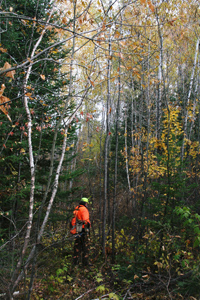 |
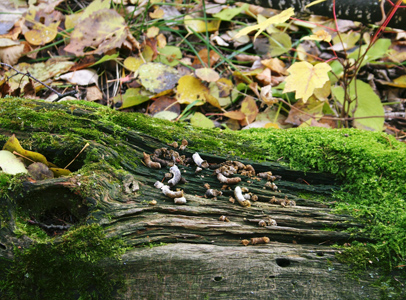 |
| Mid-October colors engulf Guide Terry Ides as he waits for Tenn to flush another grouse on family property near Fifield in Price County. | Grouse drumming logs used to attract females like this one shows bird droppings from use year after year. Even when one resident bird is taken by a hunter, another grouse takes his place on this drumming log within two weeks, said guide Terry Ides. |
Any Wisconsin sportsmen who tends to think the grass is greener somewhere else when the temperatures drop and the colors turn might look at Ides Guides in Fifield. Of course, there are pothole states where ducks fly thicker than Wisconsin and grasslands echo with more morning cackles, but very frequently, it’s the Badger state where the grass grows greener when the hunter or angler resides elsewhere.
Ides Guides, nine experts and their dogs working some of the finest ruffed grouse habitat in the world over three Wisconsin counties, know the bird; intimately. Yes, they hunt the grouse too, and the migrating woodcock with a tenacity and certainty that has earned them a clientele that come here from as far away as New York, or Georgia, or France, Italy, Japan....and on and on. But it’s the knowledge of the bird and its habitat that is most impressive to a visitor.
Terry Ides, in fact, would rather not hunt the grouse at all. He’s done enough of that, starting at age five with his father. Now, like his guides he still leads bird hunters over 40 square miles of predominantly public acres in Price and Sawyer and Ashland Counties. But, more accurately, you can call him a student of the game, or of the bird certainly; an honor student.
“The guides know how many birds were flushed, how many were killed, how many were the gray-tail phase grouse and how many were red phase,” said Ides, who runs the guide service with his wife JoAnn from 400 family acres near Park Falls. “They know every shot fired by how many clients. They know where every other guide is every day so they never bump into each other. For me this isn’t really a business. I love being out there. I lost the urge to kill and feel bad when I pull the trigger. I think I shot 10 grouse in three years.”
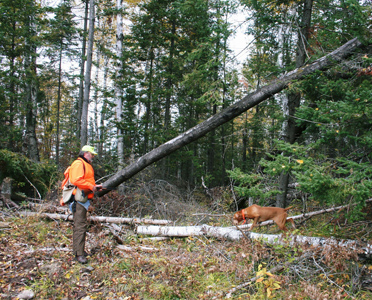 |
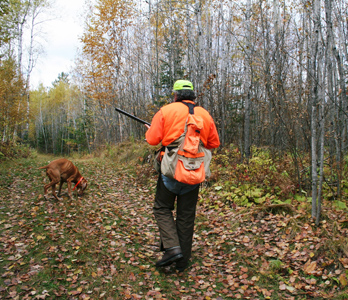 |
| Terry Ides waits for Tenn to finish the job and show him where the ruffed grouse is waiting near Fifield in Price County. | |
His personal and professional journey with the grouse began when he was five years old, tagging along with his father in these same northern forests. When he lost his dad at age 56, his hunting continued. After marriage 35 years ago, JoAnn joined her husband in the field, evolving into a fine wing shooter after extensive practice in the back yard. An impressed Terry handed her a customized SKB over and under shotgun with 23 inch barrel as an official hunter’s welcome that she still uses today.
Terry and JoAnn Ides began to build their guiding business when a relative asked if he could bring his own clients to hunt under Terry’s guidance. Indicative of the success, nationally and internationally recognized companies began to take hunting vacations or entertain clients with Ides Guides. As the Ides began to expand their horizons to include some of the finest public grouse habitat anywhere, they also purchased 40 acres of property which has expanded over the decades to 400 acres.
Knowing that grouse numbers decline in direct correlation with the decline of logging operations that leave ideal aspen habitat in its wake and provides the grouse both food and protection from predators, in the early 1980s Terry approached Price County in pursuit of tailored logging operations. He specifically asked the county, which he stressed that along with the state are today “the best of the best” in implementing calculated logging projects beneficial to wildlife, to decrease the size of its logging operations to 40 to 100 acres with five to 40 acre buffers.
The request was denied because of the potential for lost revenue, sending Terry to Pennsylvania to make a request to the Board of Directors of the National Ruffed Grouse Society that the organization would make up the difference to the county in lost revenue. The RGS agreed up to $5000. But, when smaller logging operations that were not previously able to participate in the bidding process for large sections of forest did participate in the smaller operations, the county actually realized a stumpage savings of $2.00 to $4.00 per cord.
“They made money and the grouse numbers exploded with the smaller cuts buffered by forests,” Terry Ides said.
“We have 100,000 acres of county land here and 200,000 acres of state land and 900,000 acres in the Chequamegon National Forest. With the same kind of logging practices we could go back to the old days of the 1950s with 100 bird years when logging was huge.”
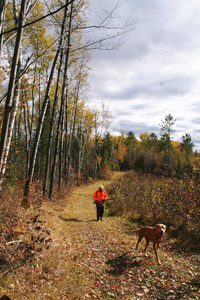 |
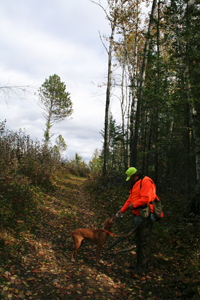 |
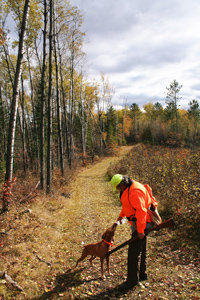 |
| Tenn leads Guide Terry Ides up a trail bordered by mature pines and a clear cut intended to produce ideal grouse aspen habitat on family property during an October hunt near Fifield in Price County. | Tenn takes a well deserved water break after working aspen stands for ruffed grouse with Guide Terry Ides on family property near Fifield in Price County. An Ides Guide service welcomes hunters from all over the world to hunt three Wisconsin counties for grouse and woodcock. | |
When forests are cut, the immature aspen “less than the size of a beer can” becomes ideal habitat for the migrating woodcock, which helicopters up from danger, and when “beer can size or larger” ideal cover for the ruffed grouse, which moves forward in escape from primarily raptors. The bird is born, Ides said, in 20 to 30 year old poplar stands before moving to alder swamps for protection. Until 12 weeks, they’re diet consists of primarily insects until about the last week of May to early June they begin follow the greens like berries, small buds of aspen and mushrooms.
By September and into October, they begin dispersal, a literal break up of the brood as individual birds walk from 100 yards to three miles in search of new habitat and new home. Ides calls it nature’s way of forming new families and avoiding incest. Some birds find good habitat and thrive, others find less suitable habitat and mortality increases.
When dispersal is complete, the grouse will live its life on a parcel that averages just 40 acres or less. For that reason, Ides strongly urges hunters to never flush and push a bird more than twice. More than that, he believes, may force the grouse off of familiar territory and greatly increase the odds for mortality before it can become acclimated to new terrain.
When six to eight inches of snow cover their hunting territory, Ides Guides have finished guiding for the year. Nothing is more important than safety in his camp, both for the hunter and his dogs.
“It’s more slippery and a shotgun is a dangerous machine,” he said. “It might be the client’s only hunt of the year. We have never even had a close call in 32 years of hunting, but an accident can happen. We talk to the hunters. We never ground swat a bird. My dogs are on the ground. We talk about how to shoot. The hunters learn to look for shooting windows on each side of the dog.”
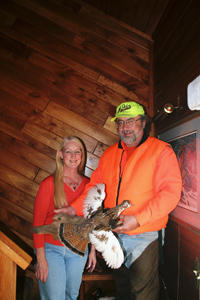
Jo Ann and Terry Ides in their Fifield home in Price County show an extremely rare albino phase ruffed grouse bagged by Terry. The guide rarely hunts but runs a nine-guide operation over Price, Ashland and Sawyer County attracting grouse and woodcock hunters from all over the world.
Each of Ides Guides will hunt with their own dogs. Terry and JoAnn have raised and hunted Vizslas, a remarkable Hungarian pointer, for 30 years since traveling to Europe to secure Thun, their first Swiss Vizsla, and Teak, which was “campaigned” shortly after from Germany. The campaign to prove to the Europeans that Terry, or any American was worthy of Vizsla ownership was long a difficult. On American soil though, Terry and Thun won or placed in competition that included the Wisconsin Open Partridge Championship, Minnesota State Open Pheasant Championship, Upper Wisconsin Open Pheasant Championship, Midwest Pheasant Championship, NAVHDA Natural Ability test and U.S. Open Championship in Amateur and Open Classes. Reflective of the dog and handler ability, one competition was won when six pheasants on 30 acres were found, pointed, shot, and retrieved in two minutes and 12 seconds.
Recently, in Price County shooting opportunities have been more than ample too, with the grouse population cycle entering its best years for bird numbers. Grouse numbers rise and fall with no known reason during the cycle. Unlike most hunters or observers who refer to a 10-year cycle, Ides refers to fluctuating numbers as a 10 year “dip” and a 20 year “dump”, with the latter more substantial. He believes the peak of bird numbers will occur next year, and watches the gray and red phase grouse as indicators of where the cycle is.
“When the red phase is up the cycle is doing well,” he said. “When the red phase is down the cycle is declining. The red bird is genetically inferior to the gray phase. In the south the birds are almost 100 percent red. They don’t have the gray phase genetics. Next year is the peak. We’ll flush 27 birds a day, then the following year 12 to 15 birds per day.”
Shooting opportunity does not always translate into hunting success. Because of the detailed statistics kept by Ides Guides, a hunter might actually feel better that he is not alone if he frequently misses a flushing ruffed grouse. Typical of those stats, one year 1,978 grouse were flushed for Ides Guides clients, 4,400 shells were spent, and just 108 birds were bagged.
Not surprisingly, it was Terry Ides work that led to Park Falls, due in part to its loam and clay soil, logging operations and easy hunter access, officially be recognized as the Ruffed Grouse Capital of the World. With the close ranging Vizsla, Tenn, doing the work, we chose to stay on some of Ides 400 acres meticulously groomed for grouse normally reserved for very old and very young hunters. Because Terry carried a gun upon this reporter’s request so that I might hunt with the camera, the guide missed two difficult shots on the only bird that offered any kind of a window.
“Hunters do no damage,” Terry Ides said. “The Ides Guides average is 1.6 grouse per day per two hunters. People feel a lot better about their own shooting ability when they find out that statistic. You’re probably not going to limit out. You might. But it’s like tagging a 10-point buck. One thing is certain tough; you stand zero chance of killing a grouse if you don’t pull the trigger.”
Contact Ides Guides at 715-762-3315 (days), 715-762-4007 (evenings), or xanadu7@dishmail.net. Connect at www.idesguides.com.







